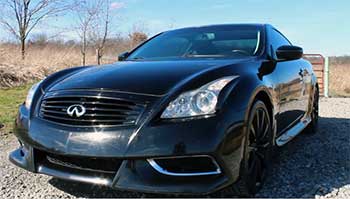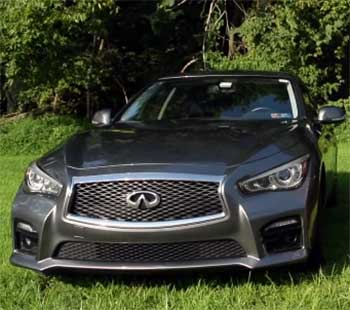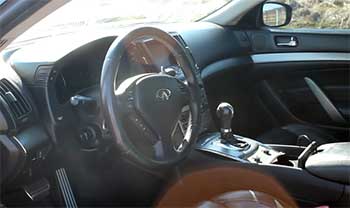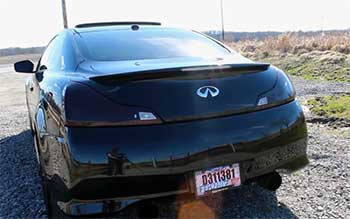I’ve always been drawn to cars that blend luxury with a punch of performance, and as an enthusiast who’s spent countless hours behind the wheel, I’m thrilled to share my take on two iconic Infiniti models: the G37S and the Q50S. My goal is to walk you through their strengths, weaknesses, and what it’s like to live with them, helping you decide which suits your driving passion. From their engines to their interiors, I’ll break it all down with a clear, engaging comparison to guide your choice.
Comparison Table: Infiniti G37S vs. Infiniti Q50S
| Feature | Infiniti G37S (2008-2013) | Infiniti Q50S (2014-Present) |
| Engine | 3.7L V6, Naturally Aspirated (330 hp) | 3.0L Twin-Turbo V6 (300-400 hp) |
| Transmission | 6-speed manual or 7-speed automatic | 7-speed automatic |
| Drivetrain | RWD or AWD | RWD or AWD |
| 0-60 mph | ~5.4 seconds (manual, RWD) | ~4.5-5.4 seconds (varies by trim) |
| Fuel Economy | 20 MPG combined (gasoline) | 23 MPG combined (premium unleaded) |
| Interior Space | 99.2 cu ft, 13.5 cu ft trunk | 101.1 cu ft, 13.5 cu ft trunk |
| Infotainment | 7-inch screen, basic navigation | Dual touchscreen (8-inch/7-inch), modern interface |
| Steering | Hydraulic, precise | Electronic, DAS optional |
| Price (Used) | $10,000-$20,000 (1-5 yrs old) | $20,000-$35,000 (1-5 yrs old) |
| Reliability | 4.0/5.0 (RepairPal) | 3.5/5.0 (RepairPal) |
| Tuning Potential | Limited (NA engine) | High (twin-turbo, 450+ hp with mods) |
My Journey with Performance Sedans
I’ve been a car enthusiast since I was old enough to turn a wrench, and performance sedans like the Infiniti G37S and Q50S hit the sweet spot of luxury and excitement. These cars promise thrilling drives without sacrificing daily practicality, making them ideal for enthusiasts like me who crave both. My experience with the G37S and Q50S comes from test drives, ownership, and diving deep into owner forums, giving me a real-world perspective on their strengths and quirks.
The G37S, a staple of the late 2000s, feels like a love letter to driving purists, while the Q50S brings modern tech and power to the table. I’ve spent hours carving corners, cruising highways, and tinkering under the hood to understand what makes these cars tick. Here’s my journey, breaking down how they compare for drivers seeking luxury with a performance edge.
Read More: Infiniti G37 Sedan vs. Infiniti Q50
Infiniti G37S Overview
The first time I slid into the driver’s seat of a 2011 Infiniti G37S, I felt like I was stepping into a cockpit built for thrill-seekers. The 3.7-liter naturally aspirated V6, producing 330 horsepower, roared with a satisfying growl that still gives me chills. It’s a car that begs you to push it, and flooring it on an open road was pure joy, hitting 60 mph in about 5.4 seconds, per Car and Driver.

Available in rear-wheel drive (RWD) or all-wheel drive (AWD), the G37S offered a 6-speed manual or 7-speed automatic.
I drove the manual, and rowing through those gears was a tactile delight, with a firm yet forgiving clutch.
The hydraulic steering was razor-sharp, making every turn feel intuitive, though the sport-tuned suspension could be harsh on rough roads.
The interior, upscale for its era, featured supportive leather seats and an analog clock that added old-school charm. The 7-inch infotainment screen and basic navigation, however, felt dated even during my ownership. With 99.2 cubic feet of interior volume and a 13.5-cubic-foot trunk, it was practical but cramped for rear passengers.
Pros of the Infiniti G37S
- Thrilling performance: 330-hp V6, hydraulic steering deliver engaging drives.
- Manual transmission option: 6-speed manual is a purist’s dream.
- High reliability: Simpler mechanics, 4.0/5.0 RepairPal rating.
- Affordable used price: $10,000-$20,000 for a performance bargain.
- Timeless design: Sleek, aggressive styling still turns heads.
Cons of the Infiniti G37S
- Dated infotainment: 7-inch screen, basic nav lack modern polish.
- Tight rear seating: 34.5 inches legroom, snug for adults.
- Poor fuel economy: 20 MPG combined, gas-hungry V6.
- Limited tuning potential: NA engine needs costly mods for big gains.
- Firm ride: Sport suspension harsh on bumpy roads.
Infiniti Q50S Overview
Stepping into a 2018 Infiniti Q50S felt like a leap into the future compared to the G37S. The 3.0-liter twin-turbo V6, available in 300-hp or 400-hp (Red Sport) variants, is a powerhouse, hitting 60 mph in 4.5-5.4 seconds, per Motor Trend. I tested the 300-hp version, and its torque-heavy pull was addictive, though turbo lag dulled low-end response compared to the G37S.

The Q50S’s 7-speed automatic shifted smoothly, but the lack of a manual option disappointed my enthusiast heart.
The optional Direct Adaptive Steering (DAS), a steer-by-wire system, felt light and precise but lacked the G37S’s tactile feedback, as noted by Edmunds.
The sport-tuned suspension balanced grip and comfort better, making it a smoother daily driver.
The interior was a big upgrade, with 101.1 cubic feet of space and plusher seats. The dual touchscreen setup (8-inch and 7-inch) was modern but occasionally laggy, per Kelley Blue Book. Fuel economy improved to 23 MPG combined, and the 16-speaker Bose audio system elevated every drive, though premium unleaded fuel is a must.
Pros of the Infiniti Q50S
- Powerful engine options: 300-400 hp twin-turbo V6, Red Sport hits 4.5 sec 0-60.
- Modern interior: Dual touchscreens, premium materials enhance comfort.
- Better fuel economy: 23 MPG combined, 580-mile highway range.
- Spacious cabin: More legroom (35.1 inches rear) for passengers.
- High tuning potential: Twin-turbo engine can reach 450+ hp with mods.
Cons of the Infiniti Q50S
- No manual transmission: Automatic-only disappoints purists.
- Numb steering: DAS feels artificial vs. G37S’s hydraulic.
- Complex electronics: More tech increases repair risks.
- Higher used price: $20,000-$35,000, pricier than G37S.
- Laggy infotainment: Dual screens can be slow, frustrating.
Performance Face-Off: Which Drives Better?
The G37S is a driver’s car through and through. Its 330-hp V6 delivers instant power with no turbo lag, and the hydraulic steering feels like an extension of your hands, as I experienced on winding backroads. The 6-speed manual made every shift a joy, though the stiff suspension jolted over potholes.
The Q50S offers more power, especially in Red Sport trim, with its 400-hp engine pulling hard through the 7-speed automatic. The suspension balances performance and comfort better, making it ideal for long highway drives, but the DAS steering felt detached on twisty roads. For raw engagement, the G37S wins; for power and daily drivability, the Q50S takes the lead.
Both cars shine in their own way. The G37S’s 5.4-second 0-60 mph time is quick, but the Q50S Red Sport’s 4.5 seconds is exhilarating. If you prioritize feel over outright speed, the G37S is unmatched; if you want modern power, the Q50S delivers.
Pros of G37S Performance
- Instant power delivery: NA V6, no turbo lag.
- Precise steering: Hydraulic system feels telepathic.
- Manual option: 6-speed gearbox engages drivers.
Cons of G37S Performance
- Stiff suspension: Harsh on rough roads.
- Slower 0-60: 5.4 seconds vs. Q50S’s 4.5.
Pros of Q50S Performance
- Powerful acceleration: 4.5-5.4 seconds 0-60 mph.
- Balanced suspension: Better comfort than G37S.
- Torque-heavy engine: Twin-turbo V6 pulls hard.
Cons of Q50S Performance
- Numb steering: DAS lacks tactile feedback.
- Turbo lag: Noticeable at low RPMs.
Interior and Technology: Old-School vs. Modern

The G37S’s interior is a snapshot of early 2010s luxury, with supportive leather seats and an analog clock adding charm.
The 7-inch infotainment screen and basic navigation were functional but dated, struggling with glare, as noted by Consumer Reports.
The Bose audio system was decent, but the tight 34.5 inches of rear legroom cramped taller passengers.
The Q50S’s cabin feels more modern, with 101.1 cubic feet of space and 35.1 inches of rear legroom, per Kelley Blue Book. The dual touchscreens (8-inch and 7-inch) were ambitious but laggy at times, and the 16-speaker Bose system was a standout for music lovers. The Q50S’s tech is a step up, but its complexity can frustrate compared to the G37S’s simplicity.
The G37S’s straightforward layout minimizes distractions, while the Q50S’s dual screens and advanced features cater to tech-savvy drivers. For daily comfort, the Q50S’s extra space and plush seats win. If you prefer a classic, driver-focused cockpit, the G37S holds its own.
Pros of G37S Interior
- Supportive seats: Comfortable for spirited driving.
- Classic design: Analog clock adds charm.
- Simple controls: Fewer distractions than modern systems.
Cons of G37S Interior
- Dated infotainment: 7-inch screen lacks polish.
- Tight rear space: 34.5 inches legroom, cramped for adults.
Pros of Q50S Interior
- Spacious cabin: 35.1 inches rear legroom, more comfortable.
- Modern tech: Dual touchscreens, advanced features.
- Premium audio: 16-speaker Bose system shines.
Cons of Q50S Interior
- Laggy infotainment: Screens can be slow to respond.
- Complex controls: Menus less intuitive than G37S.
Reliability and Maintenance
The G37S’s 3.7L V6, shared with the Nissan 370Z, is a reliable workhorse, earning a 4.0/5.0 RepairPal rating. My 2011 G37S hit 93,000 miles without major issues, needing only oil changes every 5,000-7,000 miles and occasional tire replacements. The simpler electronics reduce repair risks, though RWD models burn through rear tires with aggressive driving.
The Q50S’s twin-turbo V6 and complex tech earn a 3.5/5.0 RepairPal rating, with early models (2014-2015) facing infotainment and turbo issues, per X forums. Post-2016 models are more reliable, but repairs are pricier due to the intricate engine bay. Oil changes every 10,000 miles and mandatory premium fuel increase costs slightly.
The G37S’s simplicity makes it a low-maintenance choice for used buyers. The Q50S requires careful maintenance but holds up well with proper care. For peace of mind, the G37S edges out; for modern performance, the Q50S is worth the extra vigilance.
Pros of G37S Reliability
- High reliability: 4.0/5.0 RepairPal, proven V6.
- Simple mechanics: Fewer components to fail.
- Low maintenance costs: Basic upkeep is affordable.
Cons of G37S Reliability
- Tire wear: RWD models chew through rear tires.
- Aging components: Older cars may need suspension repairs.
Pros of Q50S Reliability
- Improved later models: Post-2016 models more reliable.
- Robust engine: Twin-turbo V6 durable with care.
- Modern features: Enhanced diagnostics aid maintenance.
Cons of Q50S Reliability
- Complex electronics: Infotainment, DAS prone to issues.
- Pricier repairs: Turbo system increases costs.
Price and Value
The G37S is a used-car steal, with 2011-2013 models priced at $10,000-$20,000, per Kelley Blue Book. Its performance-to-price ratio rivals BMWs at half the cost, making it ideal for budget-conscious enthusiasts. Depreciation is steep, but that benefits buyers, not sellers.
The Q50S, ranging from $20,000-$35,000 for 2014-2018 models, offers modern tech and power for the price. The Red Sport 400 pushes costs higher but delivers near-luxury performance. For upfront value, the G37S is unbeatable; for modern features, the Q50S justifies its premium.
Both cars offer strong value, but the G37S’s affordability makes it a gem for enthusiasts. The Q50S’s higher price reflects its newer tech and power, appealing to those willing to spend more. If budget is key, go G37S; if you want a modern edge, choose the Q50S.
Pros of G37S Price
- Affordable used price: $10,000-$20,000, performance bargain.
- Low ownership costs: Simple mechanics keep expenses down.
- High value for performance: Rivals pricier sports sedans.
Cons of G37S Price
- Steep depreciation: Hurts resale value.
- Older tech: Less appealing for modern buyers.
Pros of Q50S Price
- Modern features for price: Tech and power justify cost.
- Strong resale value: Holds value better than G37S.
- Red Sport option: Premium performance under $40,000.
Cons of Q50S Price
- Higher used cost: $20,000-$35,000, pricier than G37S.
- Premium fuel required: Increases running costs.
Modding Potential: Unleashing the Beast
The G37S’s naturally aspirated V6 is reliable but tough to tune. Cold air intakes and exhausts add modest power (10-20 hp) and better sound, but big gains require expensive turbo or supercharger kits, costing $5,000+, per X forums. My intake mod improved throttle response but didn’t transform the car.
The Q50S’s twin-turbo V6 is a tuner’s dream, with bolt-ons and tunes pushing 300 hp to 450+ hp for around $2,600, per Infiniti enthusiast sites. The Red Sport 400 responds even better, but RWD models need a limited-slip differential to manage power, especially in wet conditions. For modders, the Q50S offers far more potential at a lower cost.
The G37S suits those happy with stock performance, while the Q50S is ideal for enthusiasts chasing big power. Both benefit from suspension and brake upgrades for better handling. If tuning is your goal, the Q50S is the clear winner.
Pros of G37S Modding
- Reliable base engine: Handles basic mods well.
- Improved sound: Exhausts enhance V6 growl.
- Affordable basic mods: Intakes, exhausts under $1,000.
Cons of G37S Modding
- Limited power gains: NA engine needs costly forced induction.
- Open differential issues: RWD struggles with added power.
Pros of Q50S Modding
- High power potential: 450+ hp with bolt-ons, tunes.
- Responsive turbo engine: Easy to boost performance.
- Active tuning community: Plenty of aftermarket support.
Cons of Q50S Modding
- Drivetrain stress: High power strains components.
- Needs LSD: RWD models lose traction without upgrades.
User Reviews: What Owners Say

G37S owners on forums like MyG37.com praise the car’s raw driving feel, especially the manual transmission and hydraulic steering, calling it a “budget M3.”
The 2011-2012 models get high marks for throttle response and reliability, with a 4.0/5.0 RepairPal rating.
Complaints focus on dated tech, tight rear seats, and RWD traction issues in wet conditions.
Q50S owners on Q50Forum.com love the twin-turbo power and modern interior, especially in Red Sport trim, but criticize the DAS steering and laggy infotainment. Early models (2014-2015) faced turbo and electronic issues, though 2016+ models are more reliable, earning 3.5/5.0 from RepairPal. The Q50S’s smoother ride appeals to daily drivers, but purists miss the G37S’s engagement.
Both cars have passionate fanbases, with the G37S favored for its simplicity and the Q50S for its modern performance. Checking maintenance history is key when buying used, especially for the Q50S’s complex systems. Owner feedback helped shape my perspective, confirming the G37S’s reliability and the Q50S’s tuning potential.
Which Suits Your Lifestyle
The G37S is perfect for purists who crave a raw, engaging drive. Its manual transmission and hydraulic steering made every backroad a thrill during my ownership, and its affordability is unmatched. If you’re on a budget and love classic sports sedans, the G37S is your match.
The Q50S suits those wanting modern power and comfort. Its twin-turbo V6 and plush interior impressed me on long drives, and its tuning potential excites modders. If you prioritize tech and daily drivability, the Q50S is the better choice.
Test-driving both revealed their personalities: the G37S is a driver’s car, the Q50S a modern all-rounder. Your lifestyle—purist or pragmatist—will decide the winner. Either way, you’re getting a luxury sedan that delivers excitement.
Frequently Asked Questions
Yes, the G37S is quick, hitting 0-60 mph in about 5.4 seconds with its 330-hp V6, per Car and Driver. It’s thrilling for spirited driving, especially with the manual transmission. The RWD setup adds to the fun but requires care in wet conditions.
Absolutely, the Q50S ranges from 5.4 seconds (300 hp) to 4.5 seconds (400 hp, Red Sport) for 0-60 mph, per Motor Trend. The twin-turbo V6 delivers serious speed, making it a standout in its class. Red Sport models rival high-end competitors like the BMW M340i.
Infiniti phased out the G37S in 2013, replacing it with the Q50 lineup in 2014, as noted by Edmunds. The G37S continued as a 2014 model in some markets under the Q40 name. The Q50 marked a shift to turbocharged engines and modern tech.
This question seems unrelated to the Infiniti comparison. The Dyson Vis Nav robot vacuum has a suction power of approximately 65 air watts, per Dyson’s specs, but check the official site for exact details. For car-related questions, I’m happy to dive deeper!
Conclusion
You’re standing at a crossroads, choosing between the raw thrill of the Infiniti G37S and the modern muscle of the Q50S. I’ve lived both experiences, and each car has its magic. The G37S is a love letter to driving purists, with its manual gearbox and razor-sharp steering, while the Q50S, with its turbocharged power and plush interior, is built for those who want performance with everyday comfort.
Test-drive both, feel their personalities, and pick the one that lights up your drives. I’d love to hear which you choose—share your thoughts! Whichever you pick, you’re in for a ride that blends luxury and excitement.

